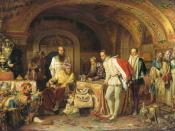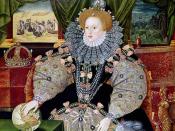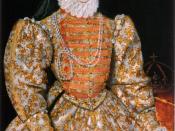In England, the period between the Gothic and Renaissance styles is known
as the Elizabethan age. It reached its peak in the late 1500s, toward the end of the
long reign of Queen Elizabeth I, and is often considered the last phase of the long-
lasting Tudor style. Although the Elizabethan age produced a certain amount of
characteristic sculptures and paintings, the Elizabethan style can best be seen in the
period's architecture. The dramatic personality of Elizabeth became the subject of a
voluminous literature (Elizabethan Age). However, the literature coming out of this
period was also quite exceptional. Among the many great writers and poets were
Edmund Spenser who wrote a very detailed piece about a feast for Elizabeth, Sir
Walter Raleigh who wrote poems about Elizabeth, and William Shakesphere
(Elizabethan Writers). The Gothic period preceding the Elizabethan age was based
very much on religion. Secular buildings, sculpture, stained glass, illuminated
manuscripts, and other decorative arts were produced in Europe during the latter
part of the Middle Ages.
Since then the term Gothic has been restricted to the last
major medieval period, immediately following the Romanesque (Gothic Period).
The Renaissance, following the Elizabethan age was a rebirth of scholarly interests.
It was based on the classics of art, religion, science and inventions, philosophy, and
humanism (Renaissance).
Queen Elizabeth I was a powerful political figure in English history. Her
background was definitely relative to her choice of words and her topics that she
used in 'When I Was Fair and Young.' Elizabeth was born in London on
September 7, 1533. She spent her childhood away from the court and received an
excellent classical education under such scholars as Roger Ascham, who influenced
her greatly (Plowden 7). Her exceptional education aided in many of her future
decisions and successes.
In 1554, Elizabeth was imprisoned on the false charge of having been
involved in Wyatt's rebellion. 'She was later released, having outwardly professed
Roman Catholicism, and regained Mary's favor' (11-12)). Mary was her sister who
locked her up because she felt threatened by Elizabeth. Mary falsely accused
Elizabeth of aiding in a Protestant rebellion. At the death of Mary in 1558,
Elizabeth became queen, beginning one of the greatest reigns in English history (15).
At the time of Elizabeth's accession, England was torn by religious strife, was
economically insecure, and was involved in a disastrous war with France (19).
'Although she was excessively vain and capricious, her monarchial duties were
always her primary concern. Her policies and her colorful personality made her
extremely popular with her subjects.' (20)
'Elizabeth's domination of the period to which her name became attached
was due in part to the exuberant national spirit that she inspired, and that
characterized all of England during the second half of the 16th century' (23). With
the religious question settled and the war with France concluded by the Treaty of
Cateau-Cambrésis in 1559, England was able to develop industrially and
economically. Under Elizabeth's direction, the government began to regulate
commerce and industry on a national scale. A new system of coinage was
introduced in 1560 to replace the silver coins that had been the basis of England's
economy throughout the previous years. As a result, prices fell to normal levels and
confidence in English money was restored. Foreign trade, encouraged by the
government, became a great capitalistic enterprise. The Royal Exchange of London
was opened in 1566, and the company of merchants, that later became the English
East India Company, was chartered in 1600 (25).
Above all this activity stood the figure of Elizabeth. 'In the eyes of her
subjects, Elizabeth was England' (Smith 36). From the beginning of her reign,
Elizabeth's marital status was a political concern because there was no English heir
to the throne. Parliament insistently asked her to marry, but she replied with the
statement that she intended to live and die a virgin, and she became known as the
Virgin Queen. 'She was besieged by royal suitors, each of whom she favored when
it was in her political interest to do so. Her affections, however, were bestowed on a
succession of favorites, notably Robert Dudley and Sir Walter Raleigh' (38). Sir
Walter Raleigh has printed poetry to Queen Elizabeth. He writes about how he
adores her and he always will find her beautiful. In one line, he refers to her by
saying 'For knowing that I sue to serve saint of such perfection' (Raleigh lines 15-
16).
'Elizabeth's most delicate political problem was that involving her Roman
Catholic cousin, Mary, Queen of Scots. Mary sought refuge in England after
being defeated in battle by her half brother, James Stuart, Earl of Moray' (43).
Elizabeth immediately imprisoned Mary because the Catholic monarches of
Europe and her own Catholic subjects considered Elizabeth illegitimate. 'By their
reasoning, Mary was the lawful Queen of England.' (45) To Elizabeth, Mary was
the potential center of conspiracy. Mary was kept captive for years, giving rise to
many plots by English Catholics for her release. 'When in 1586 Walsingham, then
Secretary of State, discovered a plot to assassinate Elizabeth and place Mary on
the throne of England, Elizabeth reluctantly agreed to have Mary executed in
1587. The execution had serious results (46-47). 'Philip II of Spain had, for
years, been troubled by the raids of English mariners on his colonial possessions.
Because Mary and Philip were Catholic, her death provided him with an added
stimulus to prosecute the war with England that had been going on since 1585'
(49). He therefore sent a fleet to invade the country in 1588. The Spanish
Armada, however, suffered an inglorious defeat, and England eventually took the
place of Spain as the great colonizer of the New World and the reigning power on
the seas (50).
Elizabeth spent the last years of her life unhappy and alone, having
outlived a glorious age, the beginning of the history of what would become modern
England. She died in London on March 23, 1603 (Plowden 53). One of her works,
'When I Was Fair and Young,' was a poem written around 1579 and released in
1590. This was about the way she felt about herself:
'When I was fair and young, and favor
graced me,
Of many was I sought, their mistress for
to be;
But I did scorn them all, and answered them
therefore,
'Go, go, go, seek some otherwhere,
Importune me no more!'
How many weeping eyes I made to pine
with woe,
How many sighing hearts, I have no skill
to show;
Yet I the prouder grew, and answered them
therefore,
'Go, go, go, seek some otherwhere,
Importune me no more!'
Then spake fair Venus' son, that proud
victorious boy,
And said, 'Fine dame, since that you be
so coy,
I will so pluck your plumes that you shall
say no more,
'Go, go, go, seek some otherwhere,
Importune me no more!'
When he had spake these words, such
change grew in my breast,
That neither night nor day since that, I
could take any rest,
Then lo! I did repent that I had said before,
'Go, go, go, seek some otherwhere,
Importune me no more!'
(Elizabeth I 173)
In this poem, I consider Elizabeth to be very conceited. In the opening
stanza, she talks about many people wanting her. She was young and beautiful,
and also the most powerful person in England (lines 1-2). Later on in that stanza,
she says how despite the numerous requests, she would reject them. Basically,
they were not worth the time (lines 3-4). In the next stanza she talks about the
numerous rejections she makes. It sounds like she's starting to almost brag (lines
5-6). She comes back with the same line as in lines three and four, saying they are
not worth it (lines 7-8) In the third stanza, someone a little more special requests
her company. He is Venus' son, Cupid. Along with his mother, they are the
patrons of love (lines 9-10). As usual, she uses the same line as the others. The
line asking them to stop wasting her time (lines 11-12). The fourth and final
stanza is different from the others. She realized that Cupid had an affect (lines 13-
14). She realized she should not have used the words that she used so often, 'Go,
go, go, seek some otherwhere, Importune me no more' (lines 15-16)! This poem
was a perfect description of her love life. As I mentioned earlier, Parliament
wanted her to marry, but she replied with the statement that she intended to live
and die a virgin, and she became known as the Virgin Queen. Her affections,
however, were bestowed on a succession of favorites, notably Robert Dudley and
Sir Walter Raleigh' (Smith 38).
Queen Elizabeth was an extremely independent woman and turned a country
of many problems into a prosperous one. She was very selective and never married,
making the successor to the throne James I, Elizabeth's cousin's son. Elizabeth's
background was definitely the reason for her style of writing. She was a remarkable
woman.



Great Essay
I think that u put ur best in this essay and it really captures the reader's attention.Good job..work on the simple errors.
1 out of 1 people found this comment useful.